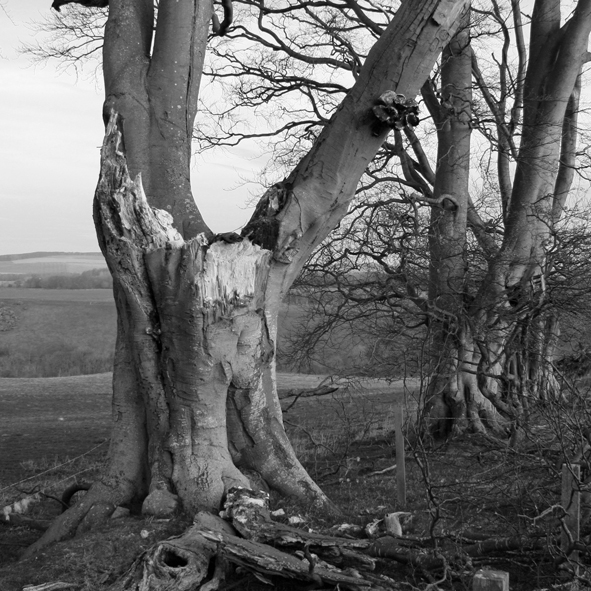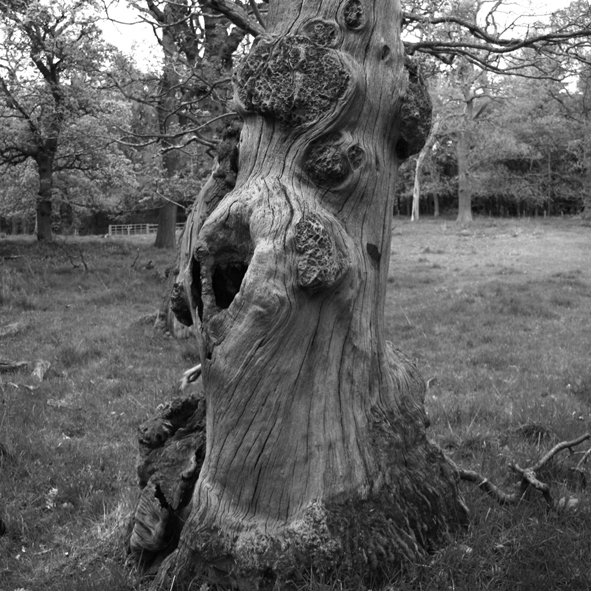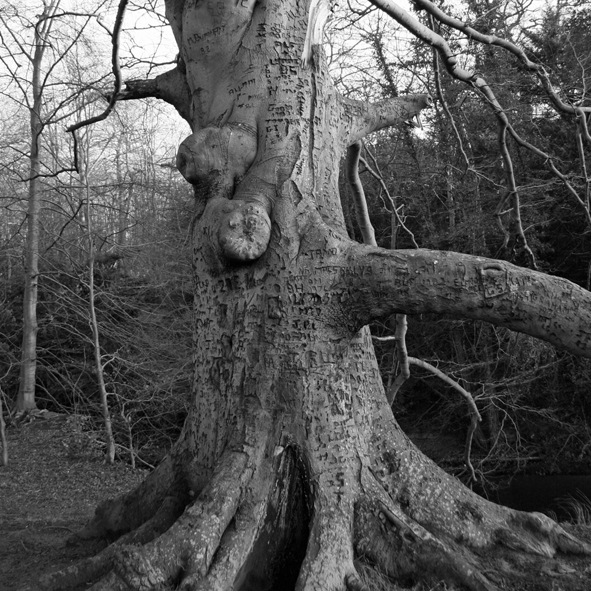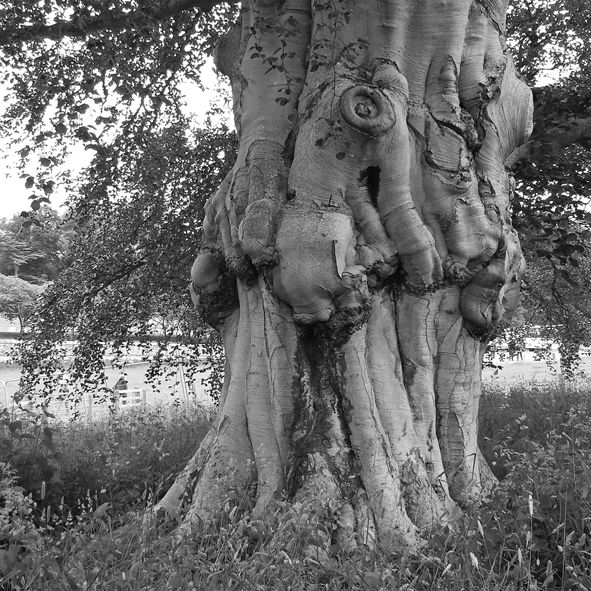These are some of the trees which have inspired the works in my current solo exhibition, ‘Time around trees’, along with some quotes from authors and scientists whose books have helped me understand and reflect on what I see.
Crichton shattered beech Near Crichton Castle, Midlothian
Here veteran beeches line a little hollow lane beside an Iron Age Fort and a neighbouring field boundary.
When I first found the site on a walk with a friend, one tree stood out in particular for its striking form, following the collapse of one of the main limbs in a recent storm. Its distinctively separate twisting trunks suggest that it may have been bundle planted, where several saplings are planted together to give the impression of an older tree. Its surface is patterned with scars and marks from graffiti, barbed wire fencing and hole boring insects.
‘Which bits of our aesthetic or emotional consciousness do rot-holes and calluses touch. What deep-rooted associations do old trees conjure up? Are they some kind of portal to understanding the deep relationship between wildness and time?’
Richard Mabey, Beechcombings
Dalkeith burred oak Dalkeith Country Park, Midlothian
These ancient oaks, in their rare wood pasture landscape, evoke for me the difference between a tree’s lifespan and that of a human.
Likely to have been at least 400 years old when it died, this tree continues to provide habitat and sustenance to the organisms of the woodland. The bark has rotted and been returned to the soil, revealing the whorls and contortions of the underlying structure. It could stand for another 200 years, dead but filled with life. As if to emphasise the point, a crow flew suddenly out of one of the holes in the trunk as I was drawing.
‘…the burr is an excrescence of would-be buds rising from somewhere deep inside the tree like a spring… A burr may arise as a reaction to some itch in the tree, a kind of benign wood tumour. What begins as disfigurement ends life as an opulent adornment.’
Roger Deakin, Wildwood
Hopetoun half tree, Hopetoun Estate, West Lothian
Before it was lopped, this beautiful beech by the side of the Bo’ness Road was a marker in the landscape for me on a regular route near home. Then one day it had simply been beheaded, perhaps it was deemed to be unsafe or diseased.
The remaining stump was at once shocking and fascinating, as the removal of the branches had revealed the torso-like sculpture of the trunk. The problems of drawing trees that I was struggling with then had been solved by the chainsaw, and a whole body of work was inspired.
‘…trees are wildlife just as deer or primroses are wildlife. Each species has its own agenda and its own interactions with human activities. If all trees were like the ideal, they would lose most of their significance, all their historic meaning, most of their beauty and most of their value as habitat.’
Oliver Rackham, Woodlands
Newbattle graffiti beech, Newbattle Abbey College, Midlothian
In the grounds of this adult education college and former Cistercian abbey, stands this single large beech on the banks of the South Esk. It has accumulated decades’ worth of carvings, initials, dates and symbols on every accessible surface. The oldest decipherable date is 1945, perhaps because there were Italian prisoners of war held in the grounds and the house was used as barracks during the war.
Coins are pressed into the bark along the tree’s massive lower limb. It’s evident that hundreds of human lives have had links with this tree.
‘To walk through an ancient wood is to tread in the footsteps of the ghosts of those who once lived and worked in the medieval and early industrial countryside.’
Ian D. Rotherham, Ancient Woodland: History, Industry and Crafts
Novar fungus beech, Novar Estate, Evanton, Easter Ross
I discovered this site on a family holiday and have drawn there in early spring for five consecutive years.
The Novar estate was laid out in the mid 1700s as a deer park and as a symbol of the laird’s status. It has many great old trees, but the beeches there are special for me.
This solitary beech stands in the parkland wearing its convoluted crown covered in lichens, its trunk stacked with bracket fungus which is recycling the heartwood.
‘… at each place where [the tree] has been bent or cut it has grown stronger, swelling into a callous like a human knee or puckering into a bump of scar tissue round the little star-cracked crater of each amputated branch. Every one of these details represents a decision, a little setback for the tree to which it responds with redoubled vigour…’
Roger Deakin, Wildwood
Scone grafted beech, Scone Palace Grounds, Perthshire
I was introduced to this tree on an Ancient Tree Forum site visit in Perthshire.
Clearly planted as an ornamental tree, this beech reflects in its bark the battle going on between the common beech rootstock and the copper beech grafted onto it. The join is unusually high, which accounts for the very visible bulges, bosses and scars, and which immediately attracted me to draw it.
‘A known tree was a solid link with the past, an embodiment of continuity. It could be welcomed as one of the family or at least the family estate. It could be appropriated as a trophy, a proof of clever husbandry, a symbol of ancient occupation or social standing.’
Richard Mabey, Beechcombings





